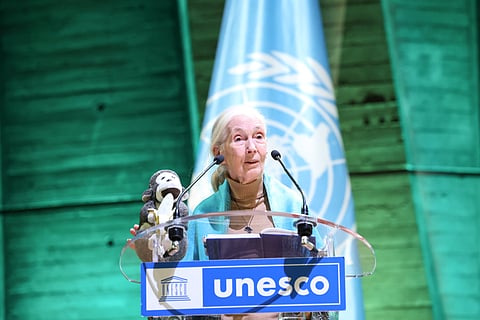

Dame Jane Goodall, who many decades ago, set standards in the disciplines of primatology and animal behaviour with her groundbreaking study of chimpanzees using tools in Gombe, Tanzania, passed away on October 1, 2025.
Goodall, who was on a tour of the United States, died of natural causes while in California, according to a statement from the Jane Goodall Institute.
Indian primatologists have paid glowing tributes to their legendary counterpart, describing her to Down To Earth (DTE) as a pioneer, a guiding voice and someone who spread a message of commitment and responsibility towards the natural world that humans share the planet with.
Narayan Sharma, Assistant Professor at the Department of Environmental Biology and Wildlife Sciences at Cotton University, Guwahati and also an Adjunct Professor at the National Institute of Advanced Studies, Bengaluru, said Goodall’s work had inspired generations.
“Jane Goodall inspired generations to pursue primatology through her pioneering research, powerful writings, and relentless commitment to spreading a message of love, compassion, and responsibility toward the natural world. With her passing, we have lost a guiding voice—one that motivated countless individuals to study and conserve our closest relatives and to safeguard the fragile habitats they depend on,” he told DTE.
Other primatologists DTE spoke to, stressed how Goodall revolutionised ideas about primates such as monkeys and great and lesser apes. Humans too are categorised as members of the taxonomic group by scientists.
“Jane Goodall dissolved the boundary between human and non-human primates, revealing a shared continuum of life,” veteran primatologist Iqbal Malik told DTE. “In her vision, they were never truly the ‘other’ but mirrors of our own becoming — voices that entered human consciousness and asked us to confront the limits of humanity. She taught us that the line between human and non-human primates is not one of division but dialogue,” she added.
Sindhu Radhakrishna, Professor of Behavioural Science at the National Institute of Advanced Studies in Bengaluru, said, “Goodall will be remembered among primatologists as somebody who did pathbreaking work and changed our very conception of primate behaviour and cognition. Among conservationists, I think she will be remembered as somebody who lived her life for chimpanzees.”
Anindya Sinha, Professor at the National Institute of Advanced Studies in Bengaluru, is known for his scientific reporting of the Arunachal macaque Macaca munzala, a species new to science and his work on cognition and consciousness among wild bonnet macaques M. radiata.
Sinha pointed out to DTE as to how Goodall was a pioneer in several respects.
He said her most important contribution is to have made common people aware of not only the plight that wild populations of chimpanzees were facing but also that of the entire natural world — how human activities have been detrimental to the natural world and how we have to preserve all that we have inherited and what we share on this planet.
“The second important lesson that she gave was about the sensitivity that we must have towards members of all species, whether human or non-human. I think she brought that amazing sensitivity in her work by pioneeringly treating each individual chimpanzee as a being who must be known. Typically, Western science models club all individuals together. We talk of species and populations. Very rarely is individuality recognised. Jane Goodall’s very important, often unrecognised and subtle contribution is that every individual matters. That, for me, is the greatest that she left for us in the world of science,” Sinha told DTE.
Finally, according to Sinha, Goodall was very unorthodox. She did use quantitative ethological methods. But much more than that, she had a social science approach to understanding the natural world.
“So, she used ethnographies. She believed in deep observations, rich accounts of individuals and through that she was able to decipher much of their biological traits, personalities. Although she has thus been criticised for not being truly scientific, I personally feel she was very innovative and much earlier than many of us, she recognised that qualitative ethnographic methods, which in a way are borrowed from the social sciences, can be very effective in understanding non-human beings. That, to me, has been a very important contribution which has largely remained unrecognised,” pointed out Sinha.